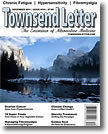|
More than ever, the public is bombarded with ideal youthful body images and optimal health. However, the effects of age, sedentary lifestyles, processed food and poor eating habits, stressful work schedules, and environmental toxins all contribute to the struggle to maintain ideal body composition.
Although society places a high value on beauty and fitness, currently two-thirds of all Americans are overweight or obese. Over the past 25 years, the number of obese individuals in the US has more than doubled. This increase occurred for all population subsets, including children, the elderly, and all racial/ethnic groups. According to the Centers for Disease Control Obesity Trends Survey 2010, 32 states had a prevalence of obesity equal to or greater than 25%; 12 states had a prevalence of obesity equal to or greater than 30%.

Obesity is a chronic, debilitating, and possibly fatal disease. It has reached epidemic proportions globally, with more than 1 billion adults overweight and with at least 300 million of them clinically obese. Obesity is a major contributor to the global burden of chronic disease and disability, and is an extremely complex medical condition affecting all demographic groups.
From an economic standpoint, the cost to produce some foods has been steadily declining. Unfortunately, these foods are high-calorie, low-nutrient-value foods that have been genetically engineered. The boom of modern technology such as the Internet, cable/satellite television, and computer games has made it acceptable to accomplish more by moving less physically. This has created a society of people who are eating more and engaging in little to no physical activity. Americans now consume 1000 more calories per week than they did in 1985, with far less movement.
Obesity and Overweight Defined
Obesity is a condition in which excess body fat may put a person at health risk and is most commonly addressed by using the body mass index (BMI) measurement. Body mass index is defined as the body weight in kilograms divided by the square of the body height in meters. A BMI over 25 kg/m2 is defined as overweight, and a BMI greater than 30 kg/m2 defines obesity.
Obesity is a multifactorial disease caused by an integration of social, behavioral, environmental, cultural, physiological, metabolic, and genetic factors. These factors involve genetic disposition, socialization, race, economic status, psychological, cultural, emotional, environmental, and social habit considerations. Overweight and obese individuals are at increased risk for many diseases and health conditions, including hypertension, osteoarthritis, dyslipidemia, type 2 diabetes, coronary heart disease, stroke, gallbladder disease, sleep apnea, respiratory problems, and some cancers (colon, prostate, kidney, breast). Psychologically, overweight and obese patients endure emotional distress, discrimination, and social stigmatization. According to the Centers for Disease Control, obese patients incur 43% higher medical costs than nonobese patients, and overall obesity-related medical conditions account for 9% of all medical spending.
Obesity Pathophysiology
Obesity is a central player in the pathophysiology of many chronic medical conditions, including diabetes mellitus, insulin resistance, dyslipidemia, hypertension, and atherosclerosis. This is mostly due to excessive adipokine secretion as a result of excess adipose tissue. Adipose tissue constitutes the largest endocrine organ that communicates with other body systems via secretion of adipokines such as leptin, adiponectin, and visfatin. Inflammatory adipokines include tumor necrosis factor alpha, interleukin-1, and interleukin-6.1
Excessive cytokine secretion contributes to lipid and glucose dysfunction and influences organ dysfunction involving cardiac, liver, pulmonary, endocrine, and reproductive systems.2 All of these factors contribute to immune dysfunction.
Visceral vs. Subcutaneous Adiposity
Abdominal adiposity is strongly associated with insulin resistance, dyslipidemia, and systematic inflammation. All play a role in the pathogenesis of cardiovascular disease, metabolic syndrome, and certain cancers. Visceral adiposity refers to the fat that accumulates around the viscera and inside intra-abdominal organs. The accumulation of visceral fat increases hepatic and adipose tissue insulin resistance, as well as metabolic abnormalities such as glucose intolerance, low HDL cholesterol, elevated triglycerides, and hypertension.1
Subcutaneous fat plays an important role in modulating peripheral insulin resistance through visceral fat accumulation. The metabolic characteristics of subcutaneous abdominal fat tend to be intermediate in nature. Additionally, many environmental toxins tend to be stored in subcutaneous fat. Many environmental toxins are known to produce weight gain, including pesticides, organophosphates, carbamates, polychlorinated biphenyls, plastics, and heavy metals.4
Subcutaneous fat has different metabolic implications than visceral fat. It is the main source of energy and free fatty acids. Most importantly, subcutaneous fat possesses thermoregulatory and nutritional functions, which are proportional to the amount of fat and its distribution. Therefore, its removal may modify metabolism.5 It was this information that prompted our exploration of the use of body sculpture as an effective form of weight loss.
Effective Obesity Treatment
We live in a society obsessed with weight and dieting. Forty percent of women and 24% of men are trying to lose weight at any given time in the US. The alarming growth rate of the obesity epidemic has resulted in a proliferation of products, devices, procedures, theories, and diets promising an end to a condition that affects so many. Unfortunately, many of these products perpetuate rather than eliminate the condition. It seems that the more this nation diets, the heavier this nation becomes. Numerous studies have shown that diets are not effective in the long run, with 90% to 95% of dieters regaining their lost weight.
Traditional weight loss strategies, such as diet, exercise, pharmacological agents, nutraceutical supplements, and, in some cases, surgery, are not new to bariatric medicine. In working with patients in regard to their body image, it became apparent that these traditional methods were not enough to break the cycle of cyclic or yo-yo dieting and eventual weight gain. It was these issues that compelled us to search for an effective approach to weight loss.
Since obesity is a multifactorial condition, it seems logical that the approach to its treatment should be multifactorial as well. The most successful approach is one wherein the following factors are considered: hormonal and neurotransmitter considerations, food allergies, environmental detoxification, nutrition/diet/nutraceuticals, gastrointestinal health, prescriptive exercise, and body sculpture. One of the most innovative and effective ways that we treat obesity is by removing subcutaneous fat using tumescent syringe body sculpture.
What is Body Sculpture?
According to Pierre Fournier, MD, one of the founding fathers of liposuction, "Bodysculpture is a modeling of the contours, a real artistic job of architecture bound to restore the juvenile and harmonic forms of the body by working with the hypodermic fatty tissues." Tumescent syringe body sculpture combines local anesthetic infiltration of dilute lidocaine and epinephrine (developed by Jeffrey Klein, MD) with subcutaneous fat removal using a small cannula. This technique is shown to be the safest method of body sculpture with the fewest complications. Fournier used the suction technique for a short time period but discovered that his results were better utilizing the syringe technique and has done so since 1985.
The safety and benefits of performing body sculpture utilizing the tumescent technique include minimal blood loss, long-lasting anesthesia that allows the patient to remain awake during the procedure, fewer infections due to antibacterial properties of the tumescent solution, and less risk of adverse events such as pulmonary embolism or hemorrhage.3
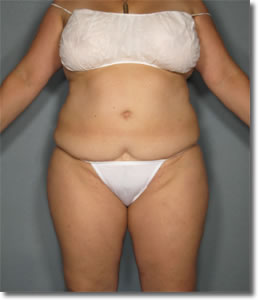
Before |
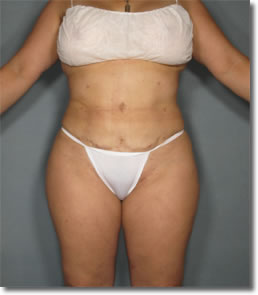
After |
There are many benefits of utilizing syringe body sculpture over procedures using a device. The use of a syringe allows for more control and precision in sculpting the body. Using a syringe also allows for accurate measurement of the fat removed, resulting in better aesthetic outcomes. Additionally, this technique results in less trauma to the adipose tissue, lessening the amount of bruising and recovery time than that experienced with device-assisted liposuction. This method also enables physicians to perform serial debulking procedures for patients who normally are not candidates for traditional liposuction. In our experience, the serial debulking procedure experience empowers patients and gives them the motivation to exercise and work toward maintaining their new figure.
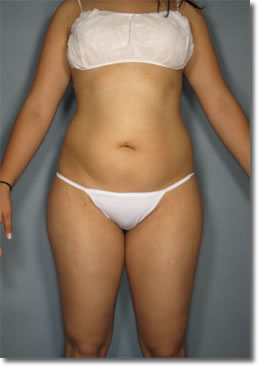
Before |
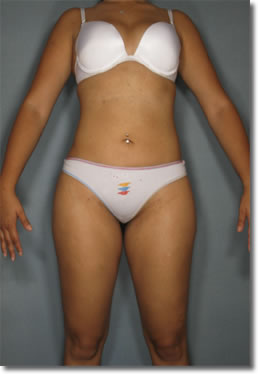
After |
Body sculpture can be safely performed on most areas of the body, including the abdomen, thighs, hips, waist, flanks, arms, calves, ankles, neck, and face. By utilizing the tumescent technique, patients are awake but comfortable during the procedure. Body sculpture is performed in a sterile, in-office procedure room using proper surgical protocols and precautions. Patients undergo a physical examination, medical history, laboratory tests, and photographs as part of the consultation process. The procedure itself takes approximately two hours. Postprocedure, patients experience a short recovery period or 24 to 48 hours in which walking and light activity are encouraged. Patients are seen three to five days postprocedure. After body sculpture, patients receive a series of lymphatic drainage and/or ultrasound treatments in order to enhance results and promote tissue tightening. Patient satisfaction is extremely high with this technique, as it offers a permanent solution to targeted fat reduction.
Clinical Liposuction Studies
There are numerous studies citing the effects of subcutaneous fat removal in regard to cardiovascular risk, insulin resistance, inflammatory markers, and lipid profile.
Saleh et al. evaluated the blood glucose and serum uric acid levels of 20 patients before, and at six-week and four-month intervals post liposuction. Analysis of fasting blood glucose levels six weeks postprocedure did not decrease significantly at six weeks, but showed a significant decrease four months postliposuction. Analysis of serum uric acid levels showed a significant decrease and six weeks and four months postliposuction, respectively.5
Giese et al. evaluated 14 women with BMI >27 kg/m2 by measuring fasting plasma insulin, triglycerides, cholesterol, body composition, and resting energy expenditure before and after liposuction. Over a four-month period, large-volume liposuction decreased weight, body fat mass, systolic blood pressure, and fasting insulin levels without detrimental effects on lean body mass, bone mass, or lipid profiles.6
Guigliano et al. evaluated insulin sensitivity and circulating levels of interleukin-6, interleukin-18, tumor necrosing factor alpha, and adiponectin in 30 obese women before and after liposuction. When compared with baseline values, liposuction was associated with reductions of body weight, insulin sensitivity, and circulating serum concentrations of interleukin-6, interleukin-18, tumor necrosing factor alpha, and C-reactive protein.7
Gonzalez-Ortiz et al. evaluated the effect of liposuction on insulin sensitivity by metabolically evaluating serum glucose, total cholesterol, HDL cholesterol, triglycerides, creatinine, and uric acid in 12 women. Findings support evidence that subcutaneous fat has a beneficial effect on glucose and uric acid concentrations, as well as insulin sensitivity.8
Most recently, Dr. Eric Swanson presented a study at the American Society of Plastic Surgeons annual meeting in September 2011. The study measured triglyceride and cholesterol levels in 322 patients undergoing liposuction. Patients whose triglyceride levels were elevated presurgery experienced an average 43% reduction in triglyceride levels postsurgery. The study also found that white blood cell counts decreased an average of 11% postliposuction. Elevated white blood cell counts are associated with inflammation linked to heart disease, obesity, hypertension, and diabetes. This study further supports the theory that subcutaneous fat is just as metabolically important as visceral fat.9
As this article goes to press, the Ageless Aesthetic Institute is conducting clinical trials to evaluate the effects of body sculpture on weight, fat mass, lipid profile, and C-reactive protein. Preliminary results support the theory that the removal of subcutaneous fat is metabolically significant in reducing the comorbid conditions associated with obesity.
The obesity epidemic has taken many years to reach pandemic proportions; the traditional reactionary approach to medicine and disease has proven ineffective in this fight. The physical removal of subcutaneous fat is a breakthrough in combating and possibly eliminating many of the chronic medical conditions associated with obesity, including insulin resistance, diabetes, dyslipidemia, hypertension, and atherosclerosis. The introduction of body sculpture, along with the applied principles of anti-aging medicine, environmental detoxification, nutrition, fitness, and so on, can serve to shift the paradigm of obesity and close the paradoxical effect of fad diets and other ineffective weight loss methods.

Notes
1. Redinger R. The pathophysiology of obesity and its clinical manifestations. Gastro Hepatol. 2007;3(11):856–863.
2. Robles-Cervantes JA et al. Modification of insulin, glucose, and cholesterol levels in nonobese women undergoing liposuction. Ann Plast Surg. 2001;52(1):61–67.
3. Housman et al. The safety of liposuction: results of a national survey. Dermatol Surg. 2002;28:710–713.
4. Baille-Hamilton P. Chemical toxins: a hypothesis to explain the global obesity epidemic. J Altern Compl Med. 2002;8(2):185–192.
5. Saleh Y et al. A large-volume liposuction: is it a safe procedure? Egypt J Plast Reconstr Surg. 2007;31(2):97–103.
6. Giese S et al. Improvements in cardiovascular risk profile with large volume liposuction. Plast Reconstr Surg. 2001;108(2):520–525.
7. Guigliano G et al. Effect of liposuction on insulin resistance and vascular inflammatory markers in obese women. Br J Plast Surg. 2004;57(3):190–194.
8. Gonzlez-Ortiz M et al. The effects of surgically removing subcutaneous fat on the metabolic profile and insulin sensitivity in obese women after large volume liposuction treatment. Horm Metab Res. 2002;34:446–449.
9. Swanson E. Prospective clinical study reveals significant reduction in triglyceride level and white cell count after liposuction and abdominoplasty. Presented at: American Society of Plastic Surgeons (ASPS) Annual Conference. Denver, CO; September 2011.



|
|



![]()
![]()
![]()
